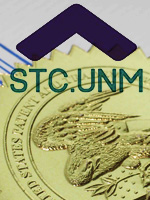Recent News
CHTM Joins NSF's NQVL Pilot Projects
August 9, 2024
OSE PHD, Dr. Xuefeng Li - Wins The Outstanding Interdisciplinary Graduate Programs Award
May 10, 2024
Dr. Ali Rastegari - 2024 OSE Best Dissertation Award Winner
May 10, 2024
2024 OSE Spring and Summer Graduates
May 10, 2024
News Archives
CHTM researchers included in UNM patent list for first quarter of 2017
April 20, 2017 - Compiled by CHTM

The U.S. Patent & Trademark Office (USPTO) issued twenty-three patents to the UNM Science & Technology Corporation (STC) during January, February, and March of 2017 for a variety of technologies created by researchers in the Departments of Molecular Genetics & Microbiology, Electrical & Computer Engineering, Chemical & Biological Engineering, Physics & Astronomy, Pathology, Computer Science, Internal Medicine, Pharmaceutical Sciences, Emergency Medicine; and the Centers for High Technology Materials, Biomedical Engineering, Global Health, Molecular Discovery, Micro-Engineered Materials and the UNM Cancer Center.
Two of these patents were issued to CHTM researchers.
Visit the original story at STC.UNM for the complete list of patents and the UNM academic departments which contributed to the research.
See the CHTM patent reports for:
• October-December, 2016
• April-September, 2016
• January - March, 2016
CHTM researchers are featured on these patents:
2017 – January, February, March
Issued Patent for Structural Illumination and Evanescent Coupling for the Extension of Imaging Interferometric Microscopy
Patent No. 9,541,374, issued January 10, 2017
Inventors: Steven Brueck, Alexander Neumann, Yuliya Kuznetsova
This technology, structured illumination microscopy (SIM), uses a low-numerical aperture (NA) microscope objective to obtain high frequency partial images using simultaneous coherent off axis illumination beams. Multiple calculations adjust the resultant images. The technology also provides different methods of creating the image. The benefits of this flexibility include a new option, requiring only minimal access to the objective pupil. Therefore, the invention is much more adaptable to current technology.
Issued Patent for Sensors Using Optical RF Oscillators
Patent No. 9,541,528, issued January 10, 2017
Inventor: Mani Hossein-Zadeh
This technology is a scheme for using the sensitivity of the oscillation frequency of optomechanical (driven by radiation pressure), thermo-optical (driven by thermo-optical effect), and thermo-optomechanical oscillators (driven by thermo-optical and thermal expansion effects) to the chemical composition of surrounding medium for detection and quantification of molecules.


